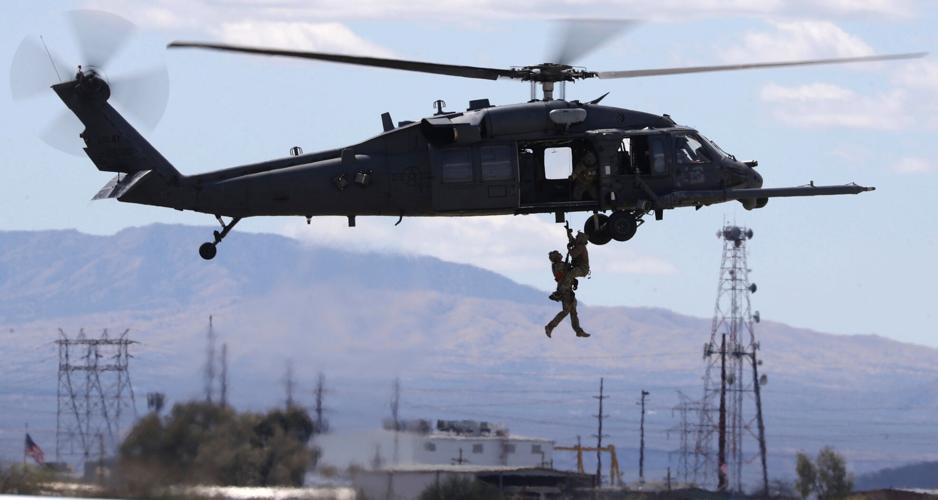Close to one out of every 40 jobs in the state is due to the fact that Arizona has multiple military bases and operations, a new report finds.
And while that’s a lower percentage than when the study was first done in 2000 — and lower in absolute number of people employed related to the military — the financial effects have nearly tripled over the same period, it says.
“Military industrial employment’’ in Arizona in 2022 was 78,780, says the study prepared by economist Alan Maguire for the Arizona Military Affairs Commission. That includes more than 42,000 who are directly employed on military facilities, including active duty, civilian workers and private contractors who work on the bases.
Add to that another 19,078 of what Maguire calls “indirect employment.’’ These are people who have jobs because they are selling goods and services directly to the military and the people who work there.
Plus Maguire figures there are another nearly 16,000 in “induced’’ employment, those further down the supply chain.
All totaled, that comes out to about 2.5% of the current total Arizona workforce.
By contrast, he said, the total employment figure in 2000 was about 83,500, or 3.8% of those working.
Yet at the same time, he said, the total output — direct, indirect and induced — went from nearly $5.7 billion in 2000 to more than $15.5 billion in the latest report.
“Fewer people, but better pay”
Some if it, Maguire explained, is due to inflation. Things are simply more expensive now than 20 years ago.
But he said there’s more to the story.
“Fewer people, but better pay,’’ he said.
That specifically includes the military.
In 2000, pay for an E-6 with four years of experience — the equivalent of a sergeant or petty officer — was $1,798 a month. By 2000 it had nearly doubled to $3,409.
Also, “Arizona is a much larger market than it was 20 years ago,’’ Maguire said.
Simply put, there are things that can be bought in Arizona now that weren’t available in 2000. That’s particularly true in rural areas.
“There’s a whole bunch of stuff you can buy in Yuma in 2023 that you couldn’t buy in 2000,’’ Maguire said. That means a greater local impact of the dollars available to spend.
Trying to safeguard bases
The Military Affairs Commission has ordered the study regularly since 2000 to show policymakers the importance of the bases.
The problem over the years has been that development is moving closer to the bases. That becomes a consideration when federal officials decide which bases are no longer needed.
Arizona was hit in the early 1990s with the closure of Williams Air Force Base in the East Valley section of Maricopa County.
More recently the threat has been to Luke Air Force Base west of Glendale where homes continue to pop up even as the facility has managed to not only avoid being shuttered but was selected as a training base for the F-35 aircraft.
There have been similar fears that construction around Davis-Monthan Air Force Base in Tucson could put that facility in jeopardy, although the Air Force formally chose D-M this year to host a new Special Operations Command Wing.
Lawmakers and local officials have enacted some zoning restrictions, though a 2010 ballot measure to allow officials to trade away state lands to other public entities to protect them against development failed.
Maguire said one of the purposes of the report is to detail how important the military is in Arizona, even beyond its relatively small footprint on the overall economy. He said that can be shown by the ever-increasing trends in spending related to the bases despite the ups and downs of the economy.
“The mortgage debt-triggered recession of 2008-2009 and the consequent fiscal impacts for state and local government highlight the benefits of a non-cyclical economic driver like the military operations,” he said.
Military retirees spend here
Maguire said the presence of the bases has another economic benefit: It attracts military retirees, people who move here when their service is up, bringing with them their outside income to buy and rent homes and spend on goods and services.
He figures there are more than 46,000 military retirees within 50 miles of a base.
Arizona lawmakers have done their part, exempting military retiree pay from state income taxes, with the argument being that they still pay taxes on things they buy.
The report confirms the importance of the state’s military bases, said Jay Bickley, president of the DM50, which works to protect the future of Davis-Monthan and expand its missions.
“The men and women who serve at them contribute greatly to the economic strength and well-being of our communities and benefit from tremendous support across the board,’’ Bickley said.
“Arizona has long been known for its contributions to national security,’’ he said. “And this year’s report affirms that fact as well shows the benefits of a symbiotic relationship between military installations and their local communities.’’
Performers get in a day's worth of rehearsals before the weekend's Thunder & Lightning Over Arizona at Davis-Manthan Air Force Base, March 24, 2023. Video Kelly Presnell / Arizona Daily Star





